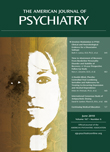DSM-IV (
1) is only a starting point for the diagnosis of posttraumatic stress disorder (PTSD). While the DSM-IV criteria for PTSD are useful in defining the disorder and distinguishing it from other diagnostic categories, there are important characteristics and subtypes commonly seen in clinical practice that affect its clinical course and response to treatment. In this issue of the
Journal, Lanius and colleagues review the clinical and neurobiological evidence of a dissociative subtype of PTSD in order to increase its recognition, accurate assessment, and effective treatment (
2).
Dissociation is described in DSM-IV as "a disruption in the usually integrated functions of consciousness, memory, identity, or perception of the environment" (p. 477). For PTSD, dissociative processes manifest as emotional numbing. For example, following an adult-onset trauma such as assault, the victim almost always recalls the events but is often numb to the feelings associated with the trauma—a presumably defensive dissociation between cognitive awareness and affect. When the dissociative barriers are breached, the victim is flooded with intrusive and intense recollections (e.g., flashbacks) of the trauma. In contrast to DSM-IV, the proposed DSM-V criteria (
3) recognize this as a dissociative process (criterion B3). DSM-V also expands on dissociative symptoms (numbing, detachment, dissociative amnesia) that are prominent in acute stress disorder (
4) and have long been associated with peritraumatic responses.
Lanius et al. describe a form of PTSD that is primarily characterized by symptoms of dissociation in the wake of prolonged traumatic experiences (e.g., chronic childhood trauma or combat experiences) that primarily manifest as chronic numbing. This is in contrast to prominent symptoms of intrusion and hyperarousal in response to acute trauma. The authors cite support for these observations in studies that use "trauma scripts" that trigger recall of the traumatic events. While many participants in these studies experienced reliving the events along with increased heart rates and other physiologic responses, others had dissociative responses and no increase in heart rate or other responses. Functional MRI studies have shown opposite responses in brain activity between these two groups in the medial prefrontal cortex, the anterior cingulate cortex, and the limbic system.
Lanius et al. postulate a subtype of PTSD characterized by overmodulation (i.e., excessive inhibition) of emotions when exposed to traumatic memories, and a subjective disengagement from the emotional content of the traumatic memory through depersonalization or derealization responses. Based on studies of brain activation in dissociative PTSD and borderline personality disorder, they hypothesize that a hyperinhibition of limbic regions by prefrontal areas occurs in situations of excessive emotional stimulation. In these patients, the relative detachment from the traumatic memories may be rooted in suppression of limbic regions with heightened frontal but diminished hippocampal activity—the hippocampus being an essential structure for the formation, storage, and retrieval of visual and verbal memory.
This corticolimbic inhibition model of a dissociative subtype of PTSD reflects many presentations commonly encountered in clinical settings. Lanius et al. cite a number of studies that suggest that the dissociative subtype is prominent among patients who have experienced chronic trauma such as prolonged childhood abuse or combat exposure. There is considerable evidence that young children have a higher level of innate dissociative capacity, which gradually decreases with increased age (
5). Thus, traumatized children may make greater use of dissociation as a way of dealing with the overwhelming effects of trauma leading to clinical syndromes of PTSD that feature prominent dissociative features. Lanius et al. also cite studies that link early onset trauma with adult symptoms of dissociation, a finding that is consistent with our research that showed strong correlations between early physical and sexual abuse and later dissociation (
6).
As noted by the authors, the syndrome of complex PTSD, described by Herman (
7) and others may be another example where a dissociative subtype of PTSD is prominent. In addition to the DSM-IV symptoms of PTSD, complex PTSD includes other commonly observed changes in emotional regulation, consciousness, perceptions, relationships, and meaning. In fact, complex PTSD—particularly since its symptoms tend to be multiple, severe, and chronic—comprises the majority of cases encountered in acute care clinical settings. Since the symptoms of complex PTSD cross over into many domains (e.g., anxiety disorders, dissociative disorders, affective disorders, and personality disorders), it is understandably difficult to fit into the DSM-IV nosology. Clinicians often need to think beyond the limitations of the DSM-IV when treating PTSD. In many ways, DSM-IV and the proposed DSM-V does not (and perhaps cannot) deal with complexity found in real clinical settings. No list of symptoms can describe the multiple state changes (e.g., in affect regulation and perceptions and assumptions about the self and environment) that can occur in the wake of severe trauma.
Finally, Lanius et al.'s identification of the dissociative subtype of PTSD may offer a rational explanation for one of the major controversies in the field of trauma psychiatry. Many of the empirically based studies that examine clinical treatment of PTSD show that exposure therapy is an effective treatment. That is, treatments that use deliberate reexposure to trauma-related stimuli (e.g., trauma scripts) are thought to result in desensitization of the trauma response and to aid in integration of the traumatic events into ordinary experience. Lanius et al. note that some authors have speculated that overmodulated responses to trauma-related stimuli may prevent the necessary full engagement in exposure. However, there may also be a protective function for the dissociation of memories, affect, and meaning for persons with chronic traumatization. Bypassing this protective function may result in persons becoming overwhelmed by reliving the trauma and finding that once again that they cannot tolerate, make sense of, or cope with their experiences. Persons with complex PTSD seem to respond better to the phase-oriented treatments that were developed in the 1990s (
8,
9), which focus on building better functioning in multiple domains prior to grappling directly with traumatic memories. The differences between the subtypes of PTSD may well account for the variations seen in disparate traumatized populations.

